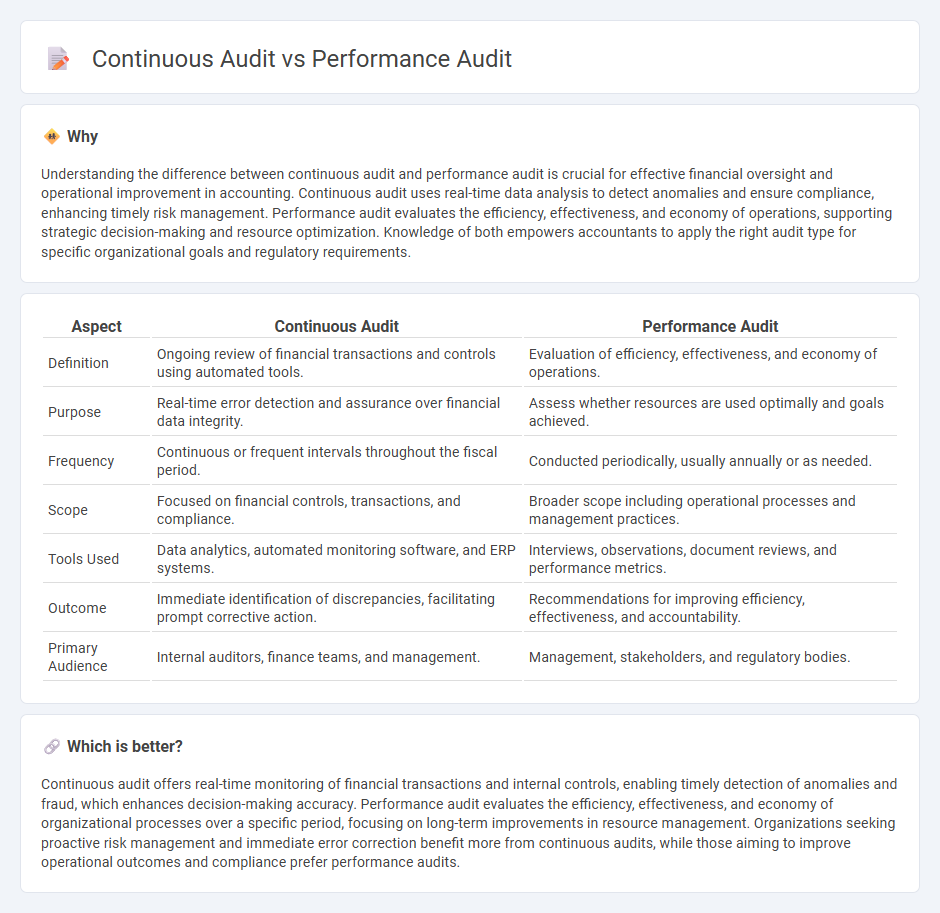
Continuous audit leverages automated tools and real-time data analysis to monitor financial transactions and controls on an ongoing basis, enhancing accuracy and early detection of anomalies. Performance audit evaluates the efficiency, effectiveness, and economy of organizational processes and programs, focusing on optimizing resource utilization and achieving strategic objectives. Explore further to understand how these audit types can transform financial oversight in your organization.
Why it is important
Understanding the difference between continuous audit and performance audit is crucial for effective financial oversight and operational improvement in accounting. Continuous audit uses real-time data analysis to detect anomalies and ensure compliance, enhancing timely risk management. Performance audit evaluates the efficiency, effectiveness, and economy of operations, supporting strategic decision-making and resource optimization. Knowledge of both empowers accountants to apply the right audit type for specific organizational goals and regulatory requirements.
Comparison Table
| Aspect | Continuous Audit | Performance Audit |
|---|---|---|
| Definition | Ongoing review of financial transactions and controls using automated tools. | Evaluation of efficiency, effectiveness, and economy of operations. |
| Purpose | Real-time error detection and assurance over financial data integrity. | Assess whether resources are used optimally and goals achieved. |
| Frequency | Continuous or frequent intervals throughout the fiscal period. | Conducted periodically, usually annually or as needed. |
| Scope | Focused on financial controls, transactions, and compliance. | Broader scope including operational processes and management practices. |
| Tools Used | Data analytics, automated monitoring software, and ERP systems. | Interviews, observations, document reviews, and performance metrics. |
| Outcome | Immediate identification of discrepancies, facilitating prompt corrective action. | Recommendations for improving efficiency, effectiveness, and accountability. |
| Primary Audience | Internal auditors, finance teams, and management. | Management, stakeholders, and regulatory bodies. |
Which is better?
Continuous audit offers real-time monitoring of financial transactions and internal controls, enabling timely detection of anomalies and fraud, which enhances decision-making accuracy. Performance audit evaluates the efficiency, effectiveness, and economy of organizational processes over a specific period, focusing on long-term improvements in resource management. Organizations seeking proactive risk management and immediate error correction benefit more from continuous audits, while those aiming to improve operational outcomes and compliance prefer performance audits.
Connection
Continuous audit leverages real-time data analysis and automated tools to provide ongoing assurance of financial transactions, enhancing the accuracy and timeliness of audit findings. Performance audit evaluates the efficiency, effectiveness, and economy of organizational operations, often utilizing insights generated from continuous audit processes. Both audit types intersect by using continuous audit data to inform performance evaluations, enabling organizations to improve internal controls and operational outcomes systematically.
Key Terms
**Performance Audit:**
Performance audit evaluates the efficiency, effectiveness, and economy of an organization's operations to ensure alignment with strategic objectives. It involves in-depth analysis of financial and operational data to identify areas for improvement and accountability. Explore how performance audits drive organizational excellence and decision-making.
Efficiency
Performance audits assess organizational efficiency by evaluating resource utilization and process effectiveness over a specific period. Continuous audits provide real-time monitoring and instant feedback, enabling immediate identification and correction of inefficiencies. Discover how integrating these audit approaches can enhance operational performance by exploring detailed methodologies and case studies.
Effectiveness
Performance audits evaluate the effectiveness of processes, controls, and resource utilization at specific points in time to identify inefficiencies and recommend improvements. Continuous audits provide real-time monitoring and ongoing assessment of controls, enabling timely detection of issues and sustained operational effectiveness. Explore how integrating both approaches can enhance overall audit effectiveness and organizational performance.
Source and External Links
Performance Audit - WallStreetMojo - This webpage provides an overview of performance audits, including their meaning, objectives, and importance in governmental and nonprofit organizations.
What is a Performance Audit? - CityAuditor - Seattle.gov - This webpage explains performance audits as evaluations of government programs to increase efficiency and effectiveness, using laws and best practices as criteria.
About Performance Audits | Washington State Auditor's Office - This webpage describes performance audits as evaluations aimed at improving the efficiency and effectiveness of government programs, providing solutions for better outcomes.
 dowidth.com
dowidth.com